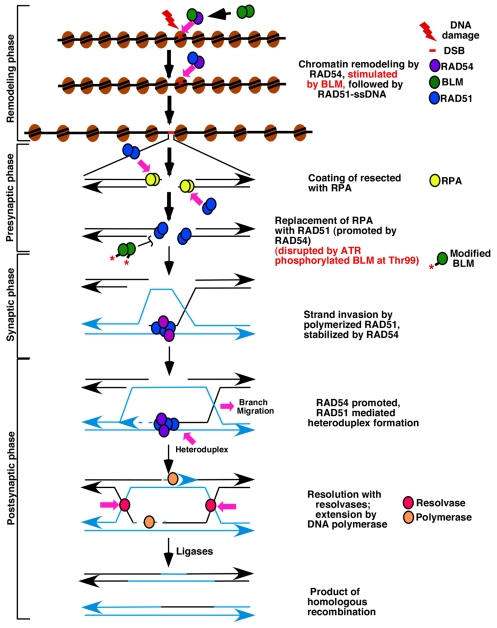Fig. 6.
Model depicting the regulation of homologous recombination by BLM as a result of alteration of RAD51 and RAD54 function. Double-strand breaks (DSBs) are recognized by the HR machinery after the chromatin-remodeling phase. BLM enhances the ATPase activity of the chromatin remodeler RAD54, thereby enhancing its remodeling activity in a homology-independent manner. Subsequently, BLM dissociates from RAD54, allowing the same region to instead bind to RAD51. The next stage of RAD54-driven chromatin remodeling is possibly homology driven and stimulated by RAD51 bound to single-stranded DNA (RAD51-ssDNA). The result of chromatin remodeling allows the sequential accumulation of proteins during subsequent stages of HR. After detection of DSB and resection of the DNA in the 5′-3′ direction, RAD51 binds to ssDNA and displaces replication protein A (RPA), which leads to RAD51 polymerization (this phase is referred to as the presynaptic phase). RAD54 promotes the nucleation of RAD51 on the RPA-coated ssDNA, thereby initiating the presynaptic phase of HR. Once the homology search is successful, the duplex is captured and the RAD51 filament invades it to form the heteroduplex structure (synaptic phase). RAD54 stabilizes the RAD51-ssDNA complex, thereby promoting this process. At synaptic phase BLM(possibly phosphorylated by ATR at Thr99) interacts with RAD51 and disrupts RAD51 filaments. Heteroduplex DNA extension and branch migration normally occurs during the postsynaptic phase of HR. DNA polymerases use the intact copy to re-synthesize the deleted DNA sequences, DNA ligases join the newly synthesized fragments and the Holliday junctions are resolved by specific endonucleases, known as resolvases. As a result of the above two activities, BLM can accurately control HR. Additional mechanistic processes, which BLM is known to use at late stages of HR, are not shown.

